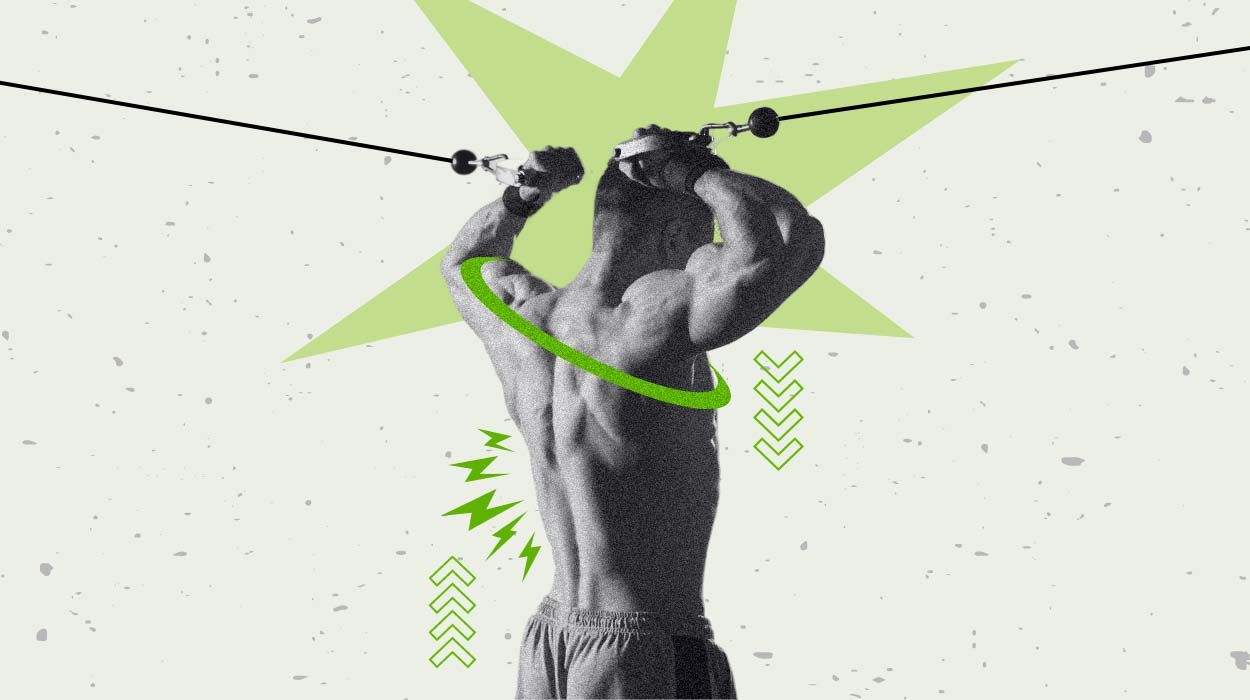
If you want to know the best back and shoulder workout, you’ve come to the right place. In this article, we share 10 incredible strength training exercises you can do to build strength and increase muscle size.
We also share the many benefits of upper body strength training and why it can improve quality of life. Whether you’re new to the gym or trying to switch it up, we’ve got you covered with the best back and shoulder muscle exercises you can do at the gym.
10 Shoulder And Back Workout Exercises You Should Try
Best Back And Shoulder Workout For Massive Size
One of the critical parts of strength training is proper form. There’s nothing worse than accidentally injuring yourself while working out. That’s why we’ve put together a step-by-step guide of some of the best workouts that target your back and shoulder muscles. There’s no shortage of exercises that target the shoulder and back muscles. Here are 10 of the best back and shoulder exercises you can do in the gym to strengthen your muscles
Seated Dumbbell Shoulder Press
This is one of the best shoulder exercises you can do with a pair of dumbbell weights. This compound exercise targets mainly the anterior deltoid muscles [1] of your shoulder. To tone your upper arms, follow these simple steps below.
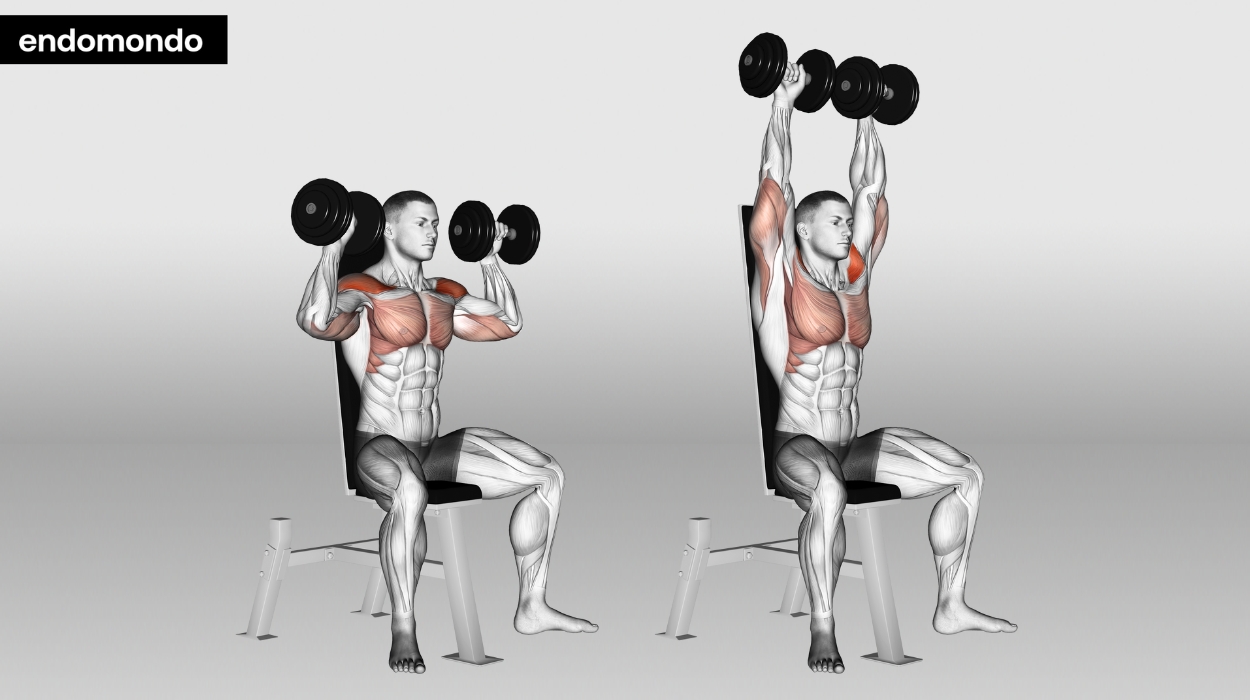
How to do:
- Find a workout bench to sit on and hold a dumbbell in each hand, palms facing forward.
- Lift the dumbbells overhead while keeping a slight bend in your elbows. The dumbells and your elbows should be at a 90-degree angle at this starting position.
- Press the weights overhead, extending your arms fully without locking your elbows.
- Lower the weights back to the starting position.
Tips:
- Engage your core for stability using your breath to press the weights up.
- Maintain a neutral spine.
- Avoid locking your elbows.
Optimal Sets And Reps: 3 sets of 10-12 reps.
Barbell Bent Over Row
This next exercise targets your upper back muscles, specifically the latissimus dorsi, trapezius, and rhomboids.[2] Follow these simple steps to get the most out of this exercise.
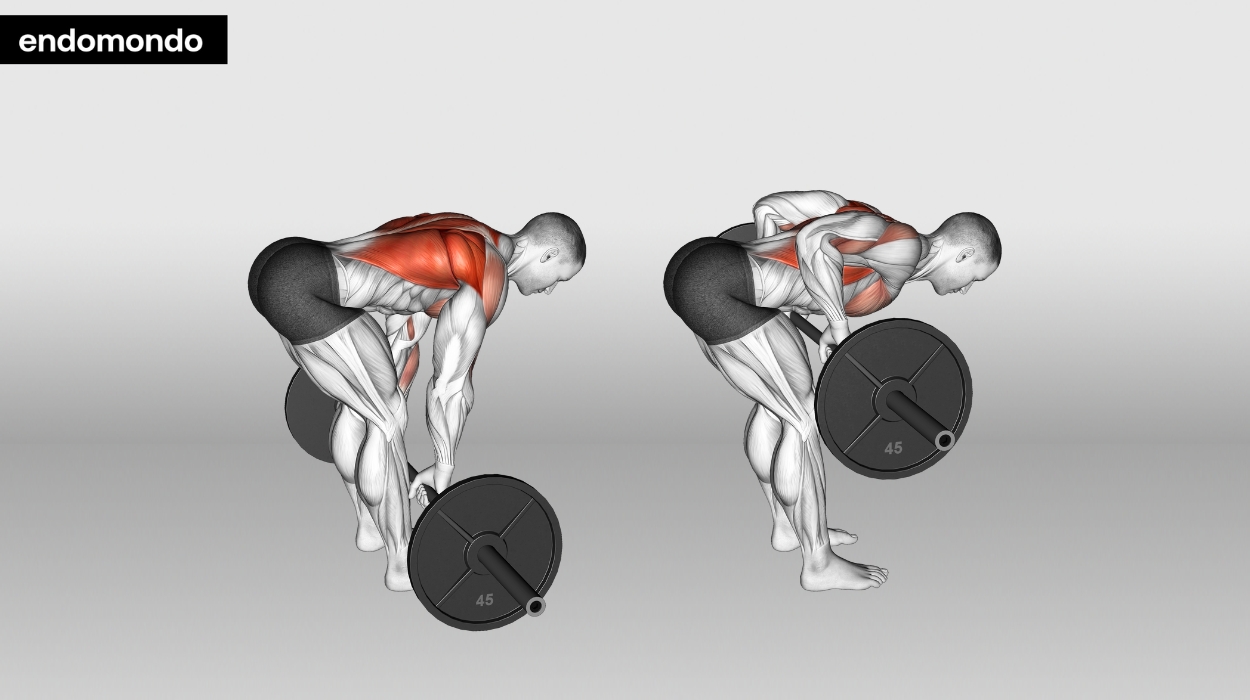
How to do:
- With your feet shoulder-width apart, hold the barbell with an overhand grip. Allow the barbell to hand directly beneath your shoulders.
- Hinge at your hips with a slight bend in your knees to lean forward, keeping your back straight and your chest up.
- Pull the barbell toward your lower chest as you squeeze your shoulder blades toward each other.
- Lower the barbell back down with control and repeat.
Tips:
- Avoid arching your back and keep your neck in a neutral position.
- Keep elbows close to your body and focus on squeezing your back muscles when you pull the barbell up to your chest.
Optimal Sets And Reps: 3 sets of 10-12 reps.
Seated Dumbbell Lateral Raise
This exercise focuses on strengthening your shoulder muscles; all you need is a pair of dumbbells to start. Follow the steps below to get the most out of this exercise.
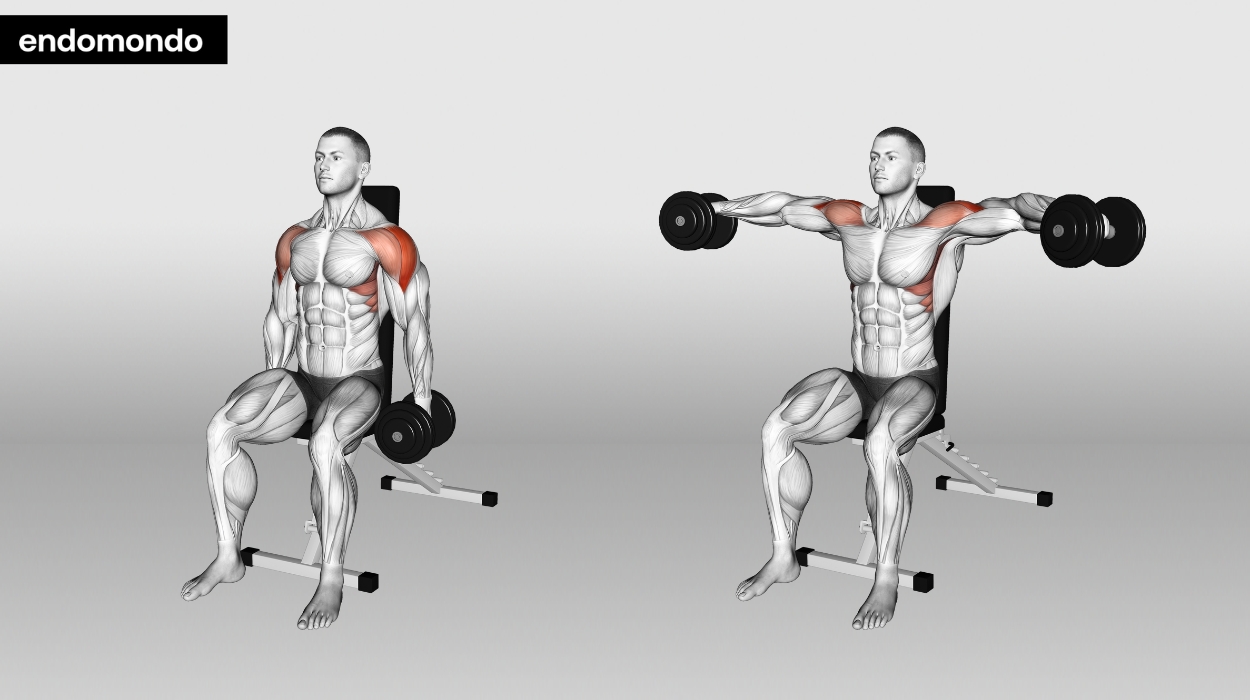
How to do:
- Sit on a bench with a dumbbell in each hand by your sides, palms facing towards you.
- Lift both dumbbells to the sides until your arms are parallel to the ground.
- Pause for a second or two at the top, focusing on contracting your shoulder muscles.
- With control, lower the dumbbells back down to the starting position and repeat.
Tips:
- Keep your back straight and relax your shoulders.
- Be sure not to lock out your elbows. Keep a soft bend to focus on shoulder activation.
- Choose a weight that feels challenging but doesn’t compromise your form so you can target the right muscles effectively.
Optimal Sets And Reps: 3 sets of 10-12 reps.
Standing Barbell Overhead Press
This is a compound exercise, meaning it targets multiple muscles at the same time. This exercise specifically targets your deltoids and pectoralis muscles.[3] Using a barbell to perform overhead presses has been shown to be more effective at engaging these muscles compared to using a machine.
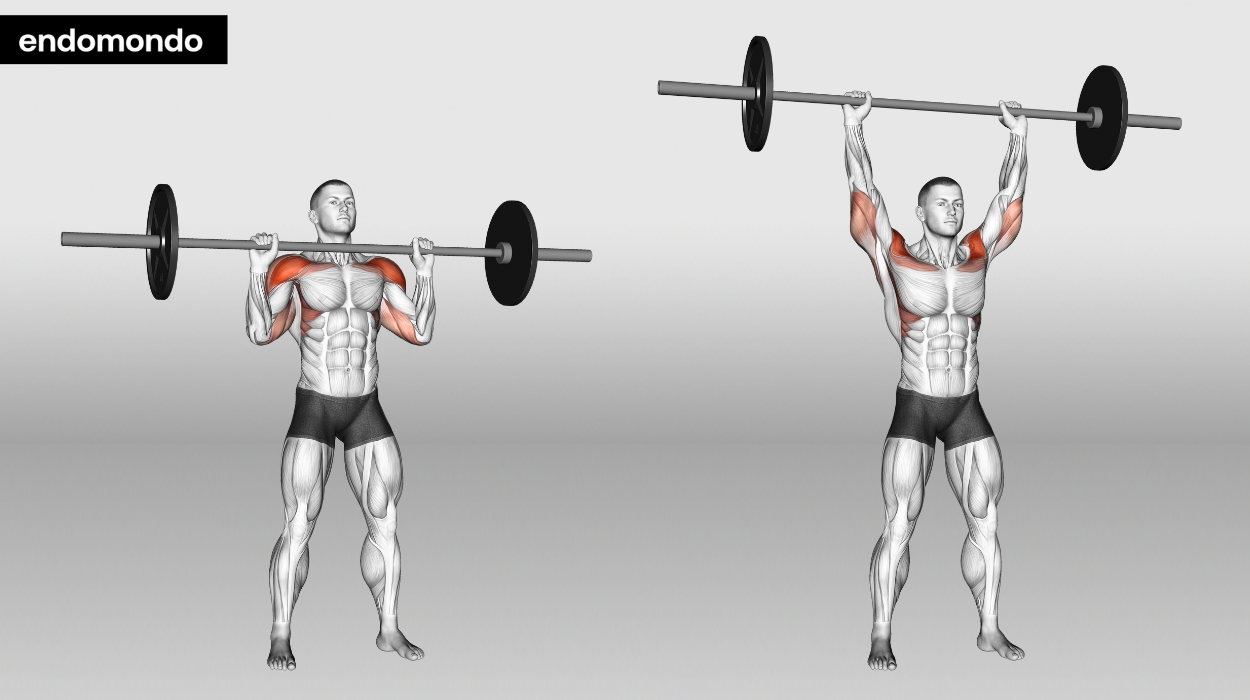
Follow these simple steps below to crush your next gym day.
How to do:
- Grip the barbell overhand while keeping your hands slightly farther than shoulder-width apart. Position the barbell at your collarbone in front of your chest.
- Press the barbell overhead while extending your arms. Fully extend your elbows without locking them.
- With control, lower the barbell back down to your collarbone level and repeat.
Tips:
- Make sure the barbell clears your head as you lift it to avoid injury.
- Keep your feet shoulder-width apart while performing this exercise.
- To maintain stability, focus on engaging your core with your breath. Exhale as you raise the barbell.
Optimal Sets And Reps: 3 sets of 10-12 reps.
Standing Dumbbell Upright Row
Another compound exercise is the upright row. This exercise targets the deltoids and trapezius muscles of the upper back.
The trapezius muscles help elevate your shoulder blades, whereas your deltoid muscles help lift your arms up while performing this movement. Here are five easy steps to do this exercise effectively.
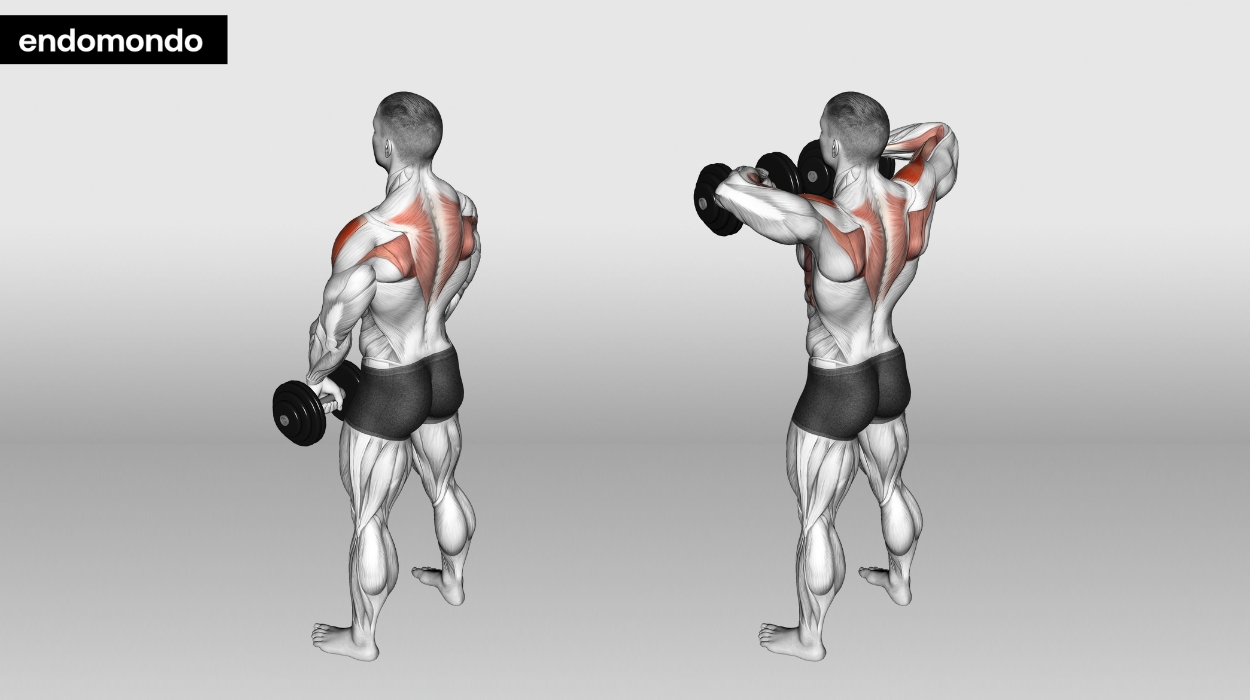
How to do:
- Begin by holding the barbell with an overhand grip and allow the barbell to hang in front of your thighs.
- Pull the barbell up toward your collarbone Make sure to lead with your elbows.
- Lift the barbell until your elbows reach shoulder height or slightly above.
- Lower the barbell back down gently to the starting position and repeat.
Tips:
- Stand with your feet shoulder-width apart.
- While performing the exercise, keep the barbell close to your body.
- Focus on squeezing your shoulder blades together during the lift.
Optimal Sets And Reps: 3 sets of 12-15 reps.
Dumbbell Rear Delt Fly
To do this exercise, all you need is a pair of dumbbells. This exercise isolates your rear deltoid, rotator cuff muscles, and upper back muscles.
Your posterior deltoids [4] are the muscles located at the back of your shoulders. The upper back muscles mainly involved are your lats and traps – assisting in retracting your shoulder blades while performing the movement. Follow these easy steps below to get started.
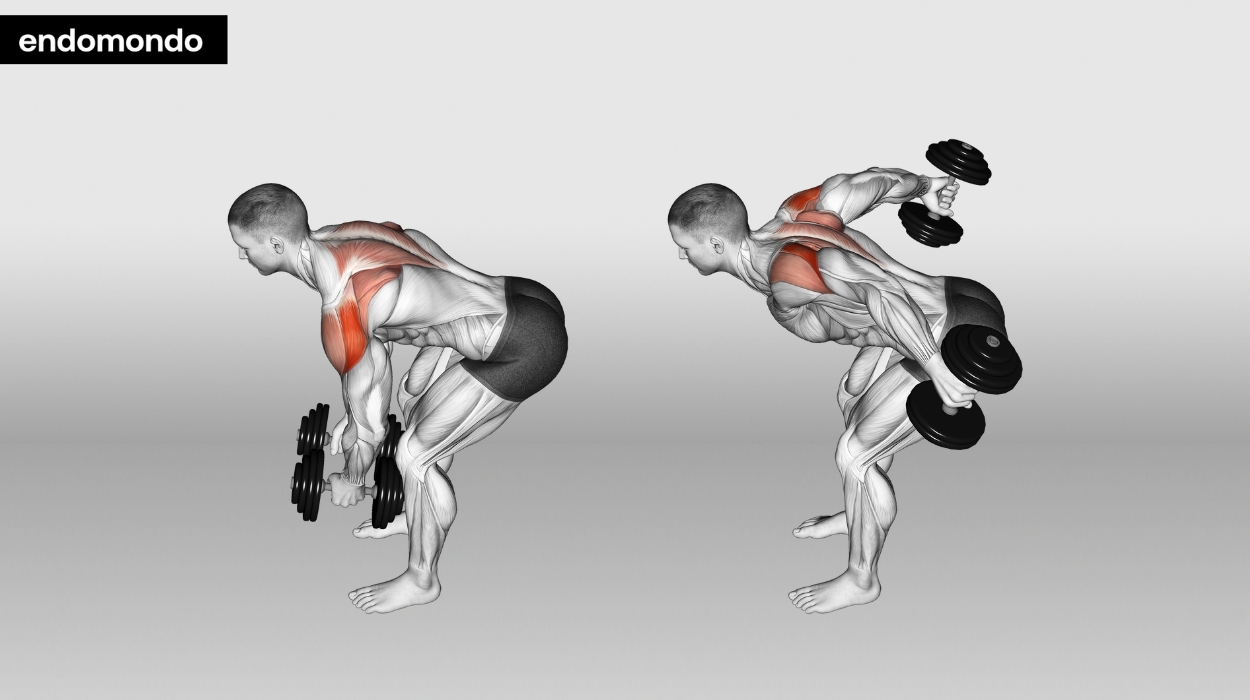
How to do:
- Hold the dumbbells with an overhand grip. Make sure your palms are facing each other.
- Hinge at your hips to bend over and let the dumbbells hang under your shoulders.
- Lift the dumbbells up and to the sides and lead with your elbows. Focus on squeezing your shoulder blades together.
- With control, lower the dumbbells back down to the starting position and repeat the exercise.
Tips:
- Don’t keep your arms straight – keep a slight bend in your elbows.
- Avoid fully extending your arms to maintain tension on the targeted muscles.
- Keep your spine straight and make sure to have a slight bend in your knees.
- Avoid engaging your neck. Keep your head neutral and pull the shoulder blades back and down.
Optimal Sets And Reps: 3 sets of 10-12 reps.
Assisted Pull-Up Machine
An assisted pull-up machine helps you build upper body strength so that one day you can do unassisted pull-ups. If you don’t have access to a machine, you can use a resistance band instead.
You can gradually adjust the weight as you become stronger at this exercise. Follow these simple steps to get started.
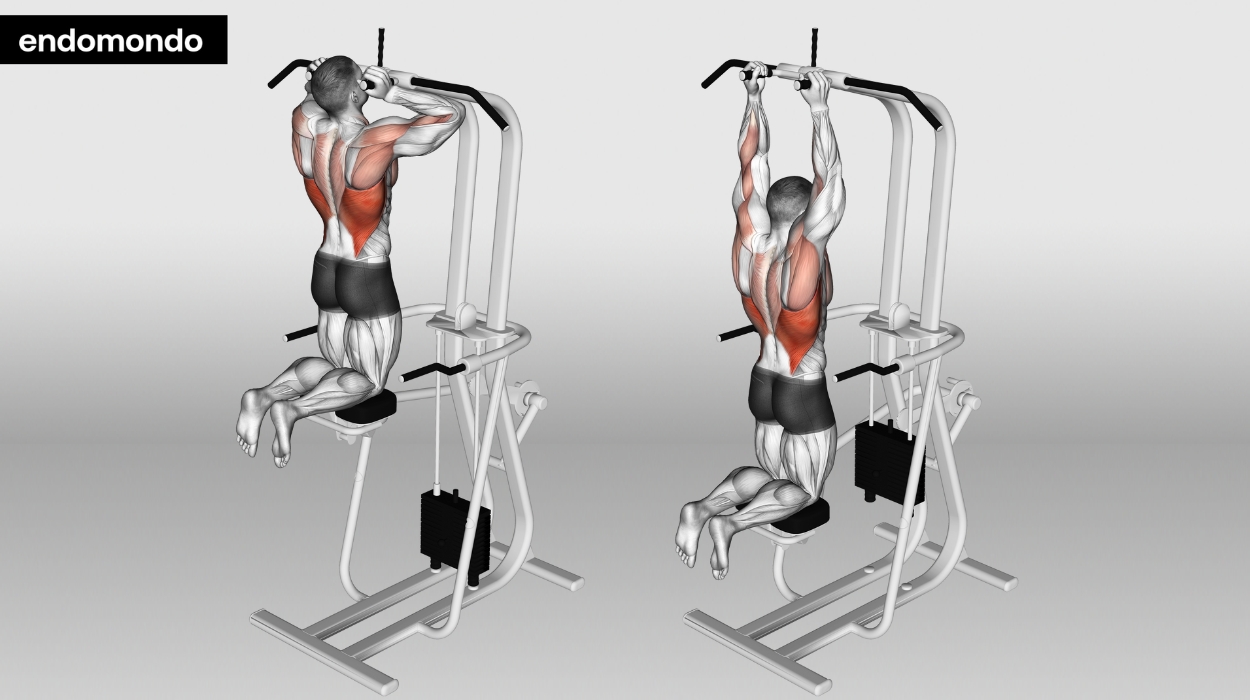
How to do:
- Set the machine to the appropriate weight.
- Stand on the machine platform and grip the pull-up bar – palms facing away from you. A wide grip will target the outer portion of your lats, whereas a neutral grip focuses on your bicep muscles more.
- Allow your body to hang freely with your arms fully extended.
- Squeeze your shoulder muscles together and pull your chest towards the bar.
- With control, lower your body back down, fully extending your arms before repeating the exercise.
Tips:
- Make sure to relax your shoulders and engage your core through your breath.
- Focus on engaging your upper back muscles to do this movement effectively.
Optimal Sets And Reps: 3 sets of 10-12 reps.
45-Degree Back Extensions
This exercise targets your erector spine and hamstrings. Make sure to pick a weight that challenges you however this exercise can be done without weights, too.
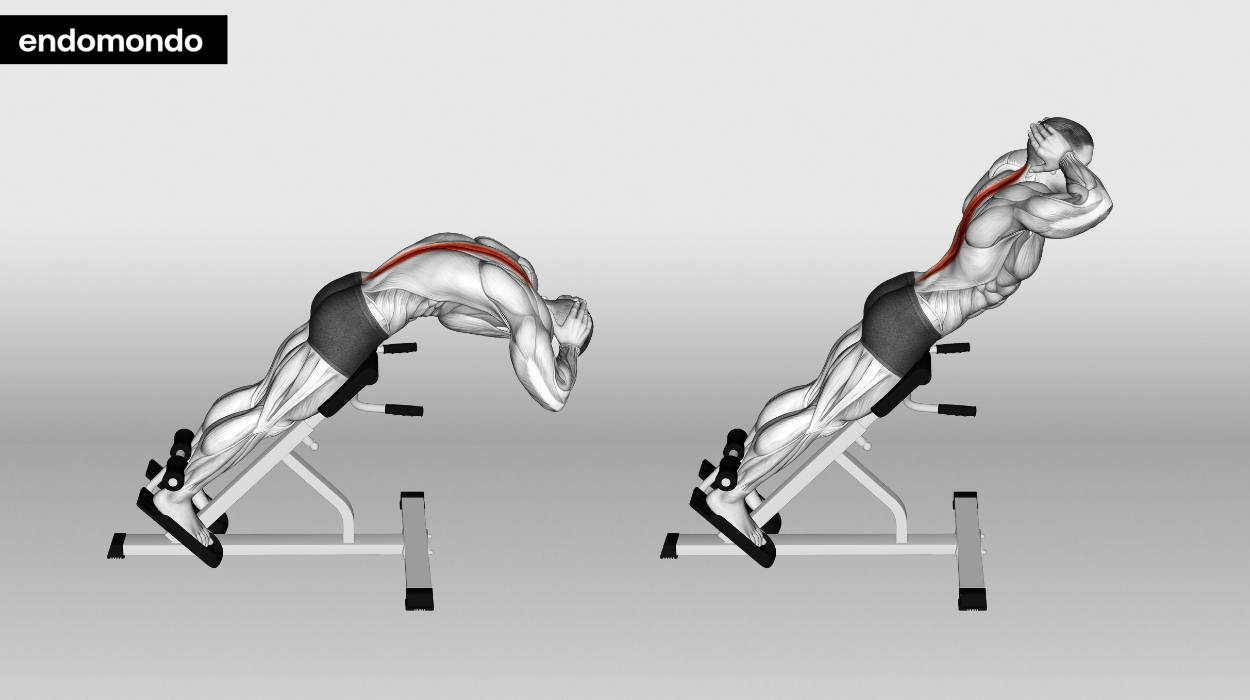
How to do:
- Position yourself on a back extension bench with your hips just above the pad. Hook your feet under the footpads.
- Bring your arms after your head or hold a weight plate against your chest.
- Hinge at your hips and lower your upper body towards the floor. Focus on keeping your back straight.
- Engage your lower back and hamstrings to lift your upper body to the starting position.
Tips:
- Keep your spine neutral by aligning your head with your spine.
- Avoid arching your back.
- Focus on using your back muscles rather than momentum to return your upper body to the starting position.
- If using a weight, ensure it’s secure against your chest to maintain proper form.
Optimal Sets And Reps: 3 sets of 10-12 reps.
Standing Dumbbell Front Raise
This shoulder workout targets your front deltoid muscles. All you need is a pair of dumbbells to get started. Follow these simple steps below.
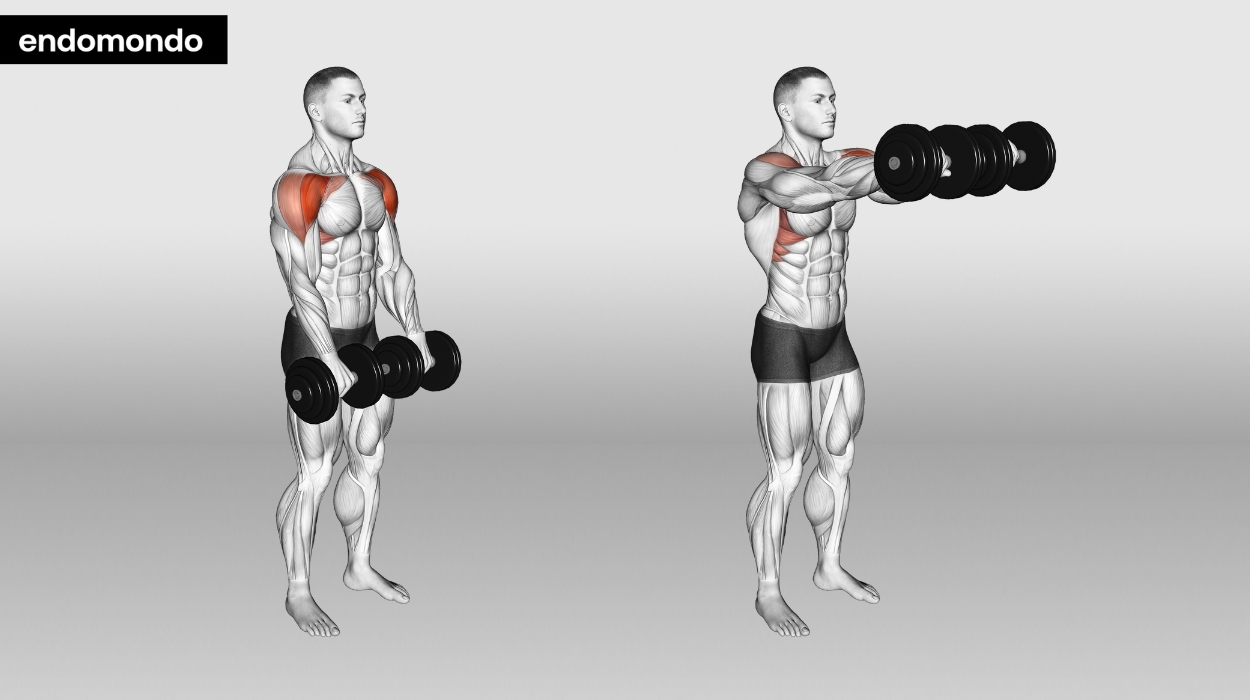
How to do:
- Stand with your feet hip-width apart.
- Let your arms hang in front of you with your palms facing your thighs while holding both dumbbells.
- Lift the dumbbells before you until parallel to the ground or slightly below shoulder height.
- Slowly lower the weights to the starting position and repeat.
Tips:
- Bend your elbows slightly and focus on keeping your spine neutral.
- Relax your shoulders.
- Engage your core with your breath to help improve stability.
- Lift the dumbbells with a controlled motion rather than momentum. Don’t lean back.
Optimal Sets And Reps: 3 sets of 10-12 reps.
Bench Barbell Chest Press
Target multiple upper body muscles with this compound exercise. Here are five easy steps to get the most out of this workout.
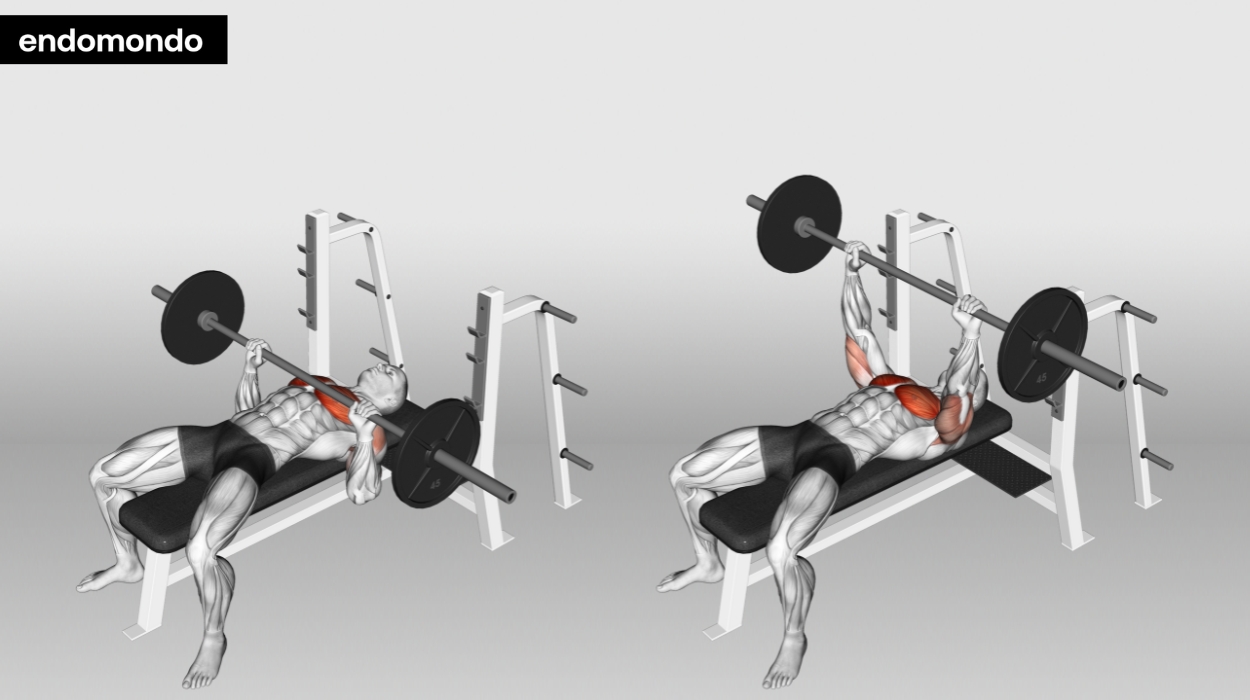
How to do:
- Keeping your feet firmly planted on the ground, lie flat on a bench. Grip the barbell with your hands slightly wider than shoulder-width apart. Make sure your eyes are aligned with the barbell.
- Pull your shoulder blades back to create a stable base.
- Slowly lower the barbell toward your chest. Allow the bar to lightly touch your chest.
- Push the barbell back up to the starting position, fully extending your arms. Repeat the exercise.
Tips:
- Keep your elbows at a 90-degree angle while lowering the barbell toward your chest.
- Focus on using your pectoralis muscles to perform the pressing motion.
- Inhale as you lower the barbell, and exhale as you press it back up to maintain a steady breathing pattern throughout the exercise and engage the core.
Optimal Sets And Reps: 3 sets of 10-12 reps.
Benefits Of Back And Shoulder Exercises
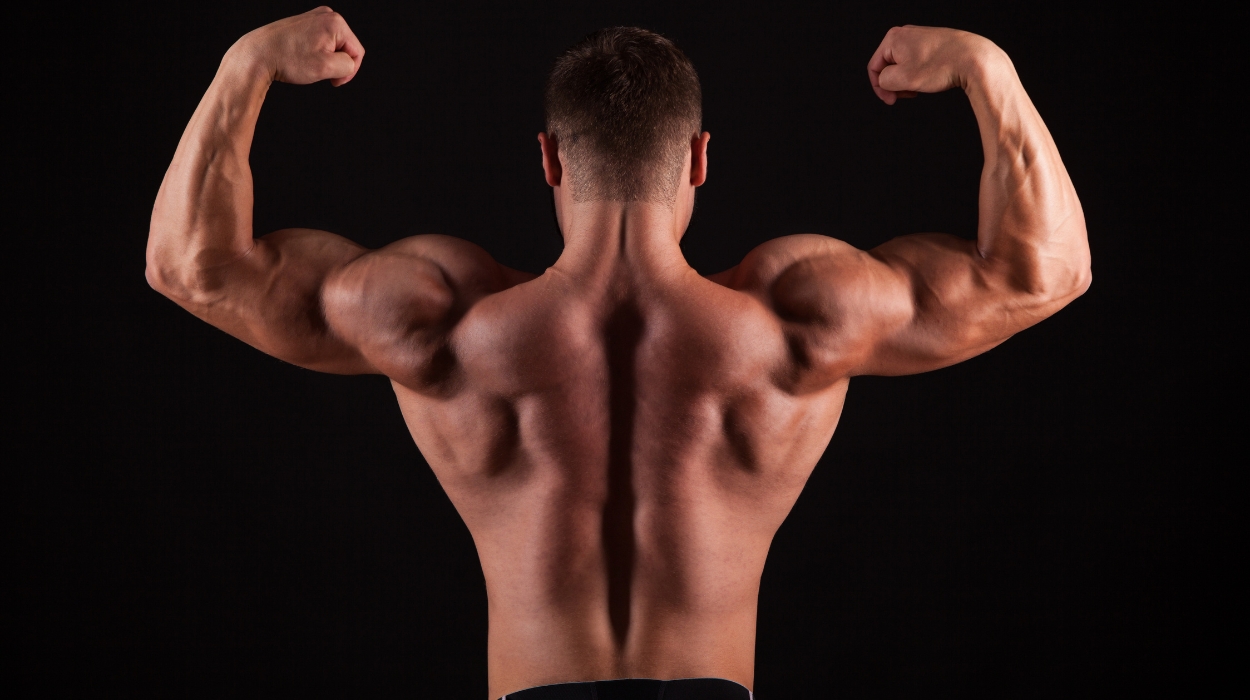
Back and shoulder exercises don’t only help with muscle gains. Let’s take a closer look at some of these benefits.
Goodbye Lower Back Pain
Studies have shown doing workout exercises that target your entire upper body can relieve and prevent chronic lower back pain.[5] People who suffer from low back pain may experience a lower quality of life due to not being able to live an active lifestyle. By engaging in strength training exercises, lower back pain can be significantly improved if done consistently.
Improved Posture
Poor posture has become a common occurrence for many adults. With so much work done sitting at a desk or staring at a screen, it’s easy to hunch your shoulders – you may not even notice it.
Sitting for long periods of time with poor posture puts strain on your lumbar spine [6] – the region of your lower back. Because of this, it can cause lower back pain when poor posture becomes chronic.
Luckily, training your back and shoulders can help combat this. One study found that participants who engaged in an 8-week exercise program [7] had significantly improved posture and decreased aches and body pains. By regularly engaging in strength training, you can improve your posture and physical health – a win-win scenario.
Prevent Injury
Strength training has been shown to help reduce your risk of injury,[8] particularly if you regularly engage in sports. This applies to competitive athletes who train more than the average individual.
However, we naturally lose muscle strength as we age. This puts many people at an increased risk for falls and fractures – leading to reduced quality of life.
Resistance training promotes muscle growth [9] and has also been shown to increase bone mineral content. Because of this, it may help prevent skeletal injuries like broken bones or fractures.
Back And Shoulder Workouts Training Volume And Recovery Tips
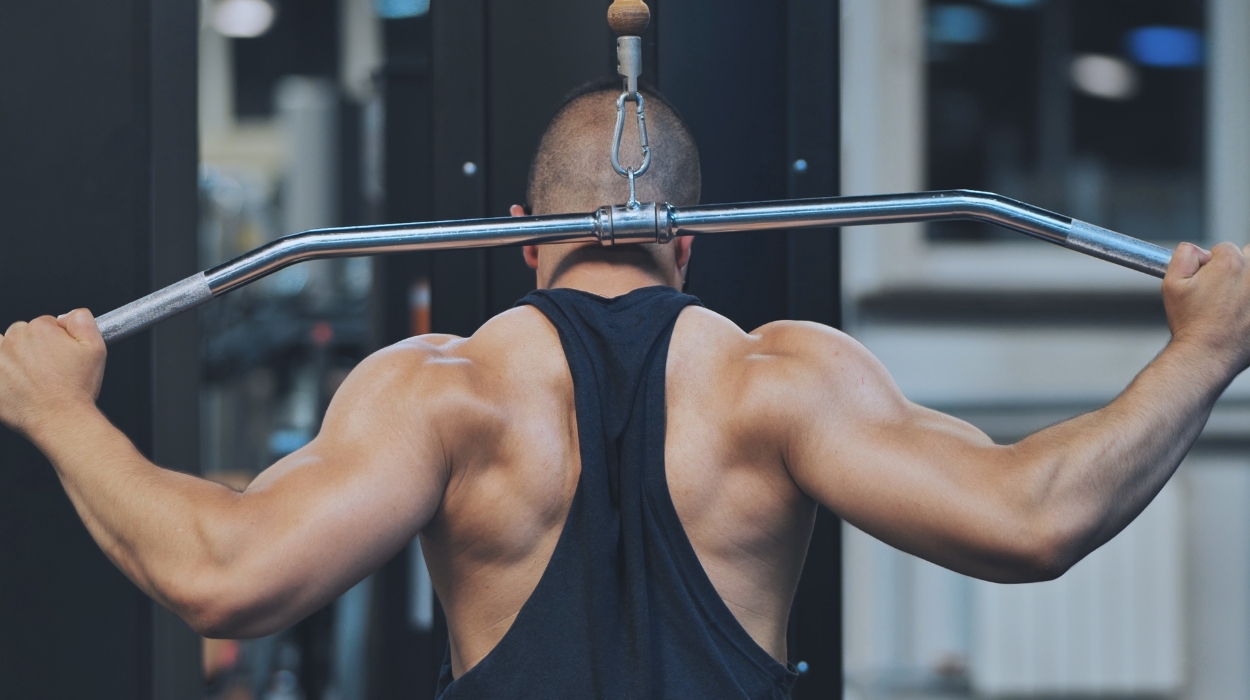
Now that you know some of the best resistance exercises to grow your back and shoulder muscles, let’s talk about how much you should train and when to rest.
Training Volume
Strength training volume is primarily determined by repetitions and sets.[10] Repetitions are how many times you do an exercise without rest, while sets refer to the number of times you repeat the amount of repetitions.
Repetition and sets play a major role in muscle mass and strength. One study found a higher volume of 28-30 sets per muscle per week is associated with increased muscle growth [11] compared to a lower-volume training program. The lower volume would be around six to ten sets per muscle weekly.
However, if muscle growth is the goal of a training program, six to twelve repetitions and three to six sets with a short rest period of 60 seconds have been shown to be beneficial in achieving those results. If you’re going for muscle hypertrophy – increased muscle mass – then three sets is a good goal. However, if you are focusing on endurance, four or more sets with a lower weight are recommended.
This is why the exercises listed below have anywhere from six to twelve reps with at least three sets since we are focusing on how to gain muscle. If you have additional questions, reach out to a personal trainer at your gym for more tips.
Recovery
Rest is an important part of strength training. Experts recommend adults engage in resistance training at least twice weekly [12] for the best effects. They also recommend prioritizing a recovery period of at least 48 hours to give the body’s muscles time to recover.
Pick a day that works best for your schedule, as it’s completely up to you. You may also find it helpful to talk to a personal trainer about how to approach rest days. To avoid overstraining your muscles, prioritize rest to get the most out of your workouts.
Conclusion
Whether you’re new to the gym or a seasoned veteran, you can do unlimited strengthening exercises that target your shoulder and back muscles. These exercises are aimed to help you build muscle strength in your upper body. We shared 10 of the best back and shoulder workouts you can do at the gym to grow muscle and stay active in your everyday life.
Some benefits of back and shoulder workouts include preventing and treating low back pain, improved posture, and injury prevention. All these benefits can contribute to a better quality of life so you can keep doing what you care most about.
Multiple studies have shown you can achieve favorable results with different approaches.[10] This means you can tailor a training program to fit your needs best.
While more research is needed on the benefits of rest days, it may help give your muscles the proper time to recover and contribute to muscle gain. By following the steps for exercises in this article, you’ll get the most out of your back and shoulder workouts in the gym and reach your goals in no time.
Frequently Asked Questions
Many shoulder and back exercises are compound exercises, meaning they often target multiple muscles at the same time. By combining these exercises, you can get the most out of your upper body workout day and save time.
The shoulder and back muscles are a great option if you want to combine muscle groups, as many exercises that target both muscles simultaneously.
There is limited research on what the best shoulder and back workout is. However, a compound exercise that targets both of these muscles is a great option. Consider barbell overhead press or dumbbell upright row.
It depends, experts recommend that you engage in strength training at least twice a week for effective results.[12] For an even body composition, you could focus on the upper body one day and the lower body the other day.
There is currently limited evidence that shows what muscle groups should or shouldn’t be trained together. With that being said, it’s important to listen to your body to prevent accidental over-strain of your muscles.
Some muscles you can easily combine with shoulders include your back, triceps, and chest.
Resources
- Campos, Y.A.C., Vianna, J.M., Guimarães, M.P., Oliveira, J.L.D., Hernández-Mosqueira, C., da Silva, S.F. and Marchetti, P.H. (2020). Different Shoulder Exercises Affect the Activation of Deltoid Portions in Resistance-Trained Individuals. Journal of Human Kinetics, 75(1), pp.5–14. doi:https://doi.org/10.2478/hukin-2020-0033.
- Ronai, P. (2017). The Barbell Row Exercise. [online] ResearchGate. Available at: https://www.researchgate.net/publication/316584445_The_Barbell_Row_Exercise.
- Coratella, G., Tornatore, G., Longo, S., Esposito, F. and Cè, E. (2022). Front vs Back and Barbell vs Machine Overhead Press: An Electromyographic Analysis and Implications For Resistance Training. Frontiers in Physiology, 13. doi:https://doi.org/10.3389/fphys.2022.825880.
- Franke, R.D.A., Botton, C.E., Rodrigues, R., Pinto, R.S. and Lima, C.S. (2015). Analysis of anterior, middle and posterior deltoid activation during single and multijoint exercises. The Journal of Sports Medicine and Physical Fitness, [online] 55(7-8), pp.714–721. Available at: https://pubmed.ncbi.nlm.nih.gov/24947920/ [Accessed 25 Jan. 2024].
- Atalay, E., Akova, B., Gür, H. and Sekir, U. (2017). Effect of Upper-Extremity Strengthening Exercises on the Lumbar Strength, Disability and Pain of Patients with Chronic Low Back Pain: A Randomized Controlled Study. Journal of Sports Science & Medicine, [online] 16(4), pp.595–603. Available at: https://www.ncbi.nlm.nih.gov/pmc/articles/PMC5721192/ [Accessed 25 Jan. 2024].
- Jung, K.-S., Jung, J.-H., In, T.-S. and Cho, H.-Y. (2020). Effects of prolonged sitting with slumped posture on trunk muscular fatigue in adolescents with and without chronic lower back pain. Medicina, [online] 57(1), p.3. doi:https://doi.org/10.3390/medicina57010003.
- Kim, D., Cho, M., Park, Y. and Yang, Y. (2015). Effect of an exercise program for posture correction on musculoskeletal pain. Journal of Physical Therapy Science, [online] 27(6), pp.1791–1794. doi:https://doi.org/10.1589/jpts.27.1791.
- Lauersen, J.B., Andersen, T.E. and Andersen, L.B. (2018). Strength training as superior, dose-dependent and safe prevention of acute and overuse sports injuries: a systematic review, qualitative analysis and meta-analysis. British Journal of Sports Medicine, 52(24), pp.1557–1563. doi:https://doi.org/10.1136/bjsports-2018-099078.
- Claudino, J.G., Afonso, J., Sarvestan, J., Lanza, M.B., Pennone, J., Filho, C.A.C., Serrão, J.C., Espregueira-Mendes, J., Vasconcelos, A.L.V., de Andrade, M.P., Rocha-Rodrigues, S., Andrade, R. and Ramirez-Campillo, R. (2021). Strength Training to Prevent Falls in Older Adults: A Systematic Review with Meta-Analysis of Randomized Controlled Trials. Journal of Clinical Medicine, 10(14), p.3184. doi:https://doi.org/10.3390/jcm10143184.
- Schoenfeld, B.J., Contreras, B., Krieger, J., Grgic, J., Delcastillo, K., Belliard, R. and Alto, A. (2018). Resistance Training Volume Enhances Muscle Hypertrophy. Medicine & Science in Sports & Exercise, [online] 51(1), p.1. doi:https://doi.org/10.1249/mss.0000000000001764.
- Krzysztofik, M., Wilk, M., Wojdała, G. and Gołaś, A. (2019). Maximizing Muscle Hypertrophy: A Systematic Review of Advanced Resistance Training Techniques and Methods. International journal of environmental research and public health, 16(24), p.E4897. doi:https://doi.org/10.3390/ijerph16244897.
- Yang, Y., Bay, P.B., Wang, Y.R., Huang, J., Teo, H.W.J. and Goh, J. (2018). Effects of Consecutive Versus Non-consecutive Days of Resistance Training on Strength, Body Composition, and Red Blood Cells. Frontiers in Physiology, [online] 9. doi:https://doi.org/10.3389/fphys.2018.00725.




